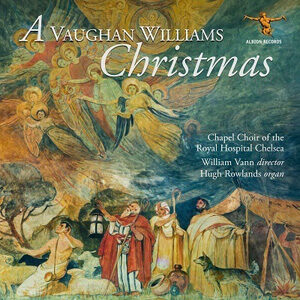As we proceed through the 12 Days of Christmas (ending on the night of January 5), there’s still time to “officially” enjoy some new seasonal recordings, and here’s one that you should definitely consider. This collection of 20 carol arrangements plus four original Christmas compositions by Ralph Vaughan Williams, with performances by a superb choir that many listeners–at least outside of England–may not know, is the kind of recording that should easily find a place in your annual holiday music rotation.
Vaughan Williams was an editor of the original (1928) version of the Oxford Book of Carols, and in compiling that famous collection he contributed a considerable number of his own arrangements, along with the above-mentioned original pieces, the latter all included here. Who knows why these four works–The Golden Carol; Wither’s Rocking Hymn; Snow in the Street; Blake’s Cradle Song (perhaps the loveliest of the group)–are not performed or recorded more often. Perhaps because they are relatively simple, un-showy settings, but they are all beautifully written and instantly gratifying–evocative, sensitive realizations of text, and here ideally sung.
Although there are many familiar carols–On Christmas Night (Sussex Carol); The Truth Sent from Above; Wassail Song (Yorkshire Wassail); O Little Town of Bethlehem (set to the English tune, Forest Green, my favorite version); There is a flower (best known as Es ist ein’ Ros’, but here with text translated by Ursula Wood, later Vaughan Williams’ wife, harmony not by VW but by Praetorius)–the program’s strength may lie in the number of lesser-known pieces, which are all traditional tunes with their own stories to tell, and are in no way inferior to those we know and sing the life out of every year. It’s also important to understand that this music was set not for concert performance but was intended to be accessible to competent amateur choirs and congregations and groups of carolers to perform–although, the quality of the arrangements is on the highest level.
No offense to the very fine women singers in The Chapel Choir of the Royal Hospital Chelsea, but my favorite section of the program was at the end: Nine Carols for male voices. Vaughan Williams wrote these in 1941 for English troops stationed in Iceland, and he clearly lavished them with the most luscious harmonies and skillful voicings he could devise while maintaining the prominence and integrity of the tunes and texts. The majority of these carols will be familiar to most listeners–included are God rest you merry, gentlemen; The First Nowell; Coventry Carol; I saw three ships; Cherry Tree Carol–and the sound, the ensemble character and quality, are as good as you’ll hear anywhere. (And it’s interesting to hear how Vaughan Williams seems to “let loose”, like nowhere else, on his arrangement of I saw three ships.) Another big plus: the notes by John Francis provide interesting historical background and pertinent, colorful descriptions of the origin of each carol and/or its arrangement. Highly recommended.
































